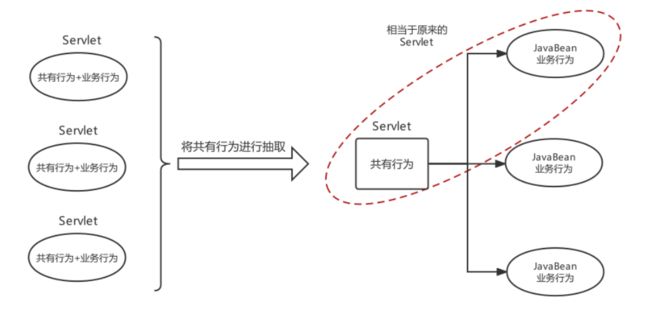Spring笔记(三)(Spring整合web环境)
01、Spring整合web环境
1.1 Javaweb三大组件及环境特点
在Java语言范畴内,web层框架都是基于Javaweb基础组件完成的,所以有必要复习一下Javaweb组件的特点
| 组件 | 作用 | 特点 |
|---|---|---|
| Servlet | 服务端小程序,负责接收客户端请求并作出响应的 | 单例对象,默认第一次访问创建,可以通过配置指定服务器启动就创建,Servlet创建完毕会执行初始化init方法。每个Servlet有一个service方法,每次访问都会执行service方法,但是缺点是一个业务功能就需要配置一个Servlet |
| Filter | 过滤器,负责对客户端请求进行过滤操作的 | 单例对象,服务器启动时就创建,对象创建完毕执行init方法,对客户端的请求进行过滤,符合要求的放行,不符合要求的直接响应客户端,执行过滤的核心方法doFilter |
| Listener | 监听器,负责对域对象的创建和属性变化进行监听的 | 根据类型和作用不同,又可分为监听域对象创建销毁和域对象属性内容变化的, 根据监听的域不同,又可以分为监听Request域的,监听Session域的,监听ServletContext域的 |
1.2 Spring整合web环境的思路及实现
在进行Java开发时要遵循三层架构+MVC,Spring操作最核心的就是Spring容器,web层需要注入Service, service层需要注入Dao(Mapper),web层使用Servlet技术充当的话,需要在Servlet中获得Spring容器
具体操作如下:
- 在第二节笔记中的转账业务模块,修改pom.xml 文件的打包方式及导包:
<packaging>warpackaging>
<dependency>
<groupId>javax.servletgroupId>
<artifactId>javax.servlet-apiartifactId>
<version>4.0.1version>
dependency>
- 创建web层,servlet
@WebServlet(urlPatterns = "/accountServlet")
public class AccountServlet extends HttpServlet {
@Override
protected void doGet(HttpServletRequest request, HttpServletResponse response) throws ServletException, IOException {
// web层调用service层,获得accountService,现在accountService在Spring容器中
ApplicationContext applicationContext = new AnnotationConfigApplicationContext(AccountConfig.class);
AccountService accountService = (AccountService) applicationContext.getBean("accountService");
accountService.transferMoney("tom","lucy",500);
System.out.println("转账操作成功");
}
@Override
protected void doPost(HttpServletRequest request, HttpServletResponse response) throws ServletException, IOException {
}
}
- 配置tomcat,部署项目,访问链接
http://localhost:8080/accountServlet
测试事务
- 模拟有异常
访问前:数据库tom:5000, lucy:5000
访问后:数据库tom:5000, lucy:5000

- 无异常
访问前:数据库tom:5000, lucy:5000
访问后:数据库tom:4500, lucy:5500

上述方案的问题:web层代码如果都去编写创建AnnotationConfigApplicationContext的代码,
那么配置类重复被加载了, Spring容器也重复被创建了,不能每次想从容器中获得一个Bean都得先创建一次容器,这样肯定是不允许。
所以,我们现在的诉求很简单,如下:
- ApplicationContext创建一次,配置类加载一次;
- 最好web服务器启动时,就执行第1步操作,后续直接从容器中获取Bean使用即可;
- ApplicationContext的引用需要在web层任何位置都可以获取到。
针对以上诉求我们给出解决思路,如下:
- 在ServletContextListener的contextInitialized方法中执行ApplicationContext的创建。或在Servlet的init 方法中执行ApplicationContext的创建,并给Servlet的load-on-startup属性一个数字值,确保服务器启动Servlet就创建;
- 将创建好的ApplicationContext存储到ServletContext域中,这样整个web层任何位置就都可以获取到了
实现:
- 在main目录下,新增
webapp/WEB-INF/web.xml目录及文件
<web-app xmlns="http://xmlns.jcp.org/xml/ns/javaee"
xmlns:xsi="http://www.w3.org/2001/XMLSchema-instance"
xsi:schemaLocation="http://xmlns.jcp.org/xml/ns/javaee
http://xmlns.jcp.org/xml/ns/javaee/web-app_3_1.xsd"
version="3.1">
web-app>
- 新建一个监听器
ContextLoaderListener,用于创建applicationContext,并存入ServletContext域中
public class ContextLoaderListener implements ServletContextListener {
@Override
// 服务器启动,ServletContext创建,该方法被执行1次
public void contextInitialized(ServletContextEvent sce) {
System.out.println("ContextLoaderListener init ....");
// 1. 创建spring容器
ApplicationContext applicationContext = new ClassPathXmlApplicationContext("applicationContext.xml");
// 2. 将容器存储到servletContext域中
sce.getServletContext().setAttribute("applicationContext",applicationContext);
}
}
- 修改
AccountServlet类中applicationContext的获取方式,改为从ServletContext域中获取
package com.mem.web;
import com.mem.config.AccountConfig;
import com.mem.service.AccountService;
import org.springframework.context.ApplicationContext;
import org.springframework.context.annotation.AnnotationConfigApplicationContext;
import javax.servlet.*;
import javax.servlet.http.*;
import javax.servlet.annotation.*;
import java.io.IOException;
@WebServlet(urlPatterns = "/accountServlet")
public class AccountServlet extends HttpServlet {
@Override
protected void doGet(HttpServletRequest request, HttpServletResponse response) throws ServletException, IOException {
// web层调用service层
// 从ServletContext域中获取applicationContext对象
ApplicationContext applicationContext =
(ApplicationContext) request.getServletContext().getAttribute("applicationContext");
AccountService accountService = (AccountService) applicationContext.getBean("accountService");
accountService.transferMoney("tom","lucy",500);
System.out.println("转账操作成功####");
}
@Override
protected void doPost(HttpServletRequest request, HttpServletResponse response) throws ServletException, IOException {
}
}
- 将新建的监听器配置到web.xml中
<listener>
<listener-class>com.mem.listener.ContextLoaderListenerlistener-class>
listener>
- 测试,结果同上
上述方案问题描述:
在ContextLoaderListener类中,配置文件的名称和容器的名称都写死了,不太友好;
解决方法:
利用常量进行解耦
改进:
- 在web.xml文件中,新增全局参数
<context-param>
<param-name>contextConfigLocationparam-name>
<param-value>classpath:applicationContext.xmlparam-value>
context-param>
- 修改ContextLoaderListener中的代码
public class ContextLoaderListener implements ServletContextListener {
private String CONTEXT_CONFIG_LOCATION = "contextConfigLocation";
@Override
// 服务器启动,ServletContext创建,该方法被执行1次
public void contextInitialized(ServletContextEvent sce) {
System.out.println("ContextLoaderListener init ....");
ServletContext servletContext = sce.getServletContext();
// 0. 获取contextConfigLocation配置文件的名称
String contextConfigLocation = servletContext.getInitParameter(CONTEXT_CONFIG_LOCATION);
contextConfigLocation = contextConfigLocation.substring("classpath:".length());
// 1. 创建spring容器
ApplicationContext applicationContext = new ClassPathXmlApplicationContext(contextConfigLocation);
// 2. 将容器存储到servletContext域中
servletContext.setAttribute("applicationContext",applicationContext);
}
}
- 新建一个工具类
WebApplicationContextUtils获取applicationContext对象
public class WebApplicationContextUtils {
public static ApplicationContext getWebApplicationContext(ServletContext servletContext){
ApplicationContext applicationContext = (ApplicationContext) servletContext.getAttribute("applicationContext");
return applicationContext;
}
}
- 修改
AccountServlet类中applicationContext的获取方式
@WebServlet(urlPatterns = "/accountServlet")
public class AccountServlet extends HttpServlet {
@Override
protected void doGet(HttpServletRequest request, HttpServletResponse response) throws ServletException, IOException {
// web层调用service层,从getWebApplicationContext()方法中获取applicationContext对象
ApplicationContext applicationContext = WebApplicationContextUtils.getWebApplicationContext(request.getServletContext());
AccountService accountService = (AccountService) applicationContext.getBean("accountService");
accountService.transferMoney("tom","lucy",500);
System.out.println("转账操作成功####");
}
@Override
protected void doPost(HttpServletRequest request, HttpServletResponse response) throws ServletException, IOException {
}
}
1.3 Spring的web开发组件spring-web
到此,就将一开始的诉求都解决了,当然我们能想到的Spring 框架自然也会想到,Spring其实已经为我们定义 好了一个ContextLoaderListener,使用方式跟我们上面自己定义的大体一样,但是功能要比我们强百倍,所以 ,遵循Spring “拿来主义” 的精神,我们直接使用Spring提供的就可以了,开发如下:
- 先导入Spring-web的坐标:
<dependency>
<groupId>org.springframeworkgroupId>
<artifactId>spring-webartifactId>
<version>5.3.9version>
dependency>
- 在web.xml中去配置ContextLoaderListener,并指定配置文件的位置
<listener>
<listener-class>org.springframework.web.context.ContextLoaderListenerlistener-class>
listener>
- 在Servlet中直接使用,改成官方的
WebApplicationContextUtils
import org.springframework.web.context.support.WebApplicationContextUtils;
@WebServlet(urlPatterns = "/accountServlet")
public class AccountServlet extends HttpServlet {
@Override
protected void doGet(HttpServletRequest request, HttpServletResponse response) throws ServletException, IOException {
// web层调用service层
ApplicationContext applicationContext = WebApplicationContextUtils.getWebApplicationContext(request.getServletContext());
AccountService accountService = (AccountService) applicationContext.getBean("accountService");
accountService.transferMoney("tom","lucy",500);
System.out.println("转账操作成功####");
}
@Override
protected void doPost(HttpServletRequest request, HttpServletResponse response) throws ServletException, IOException {
}
}
- 测试,结果同上,容器名:XmlWebApplicationContext
如果核心配置类使用的是注解形式的,那么Spring容器是AnnotationConfigWebApplicationContext,如下配 置方式
<context-param>
<param-name>contextClassparam-name>
<param-value>com.mem.web.MyAnnotationConfigWebApplicationContextparam-value>
context-param>
两个配置方式都打开,按配置类的方式创建容器,容器名是 MyAnnotationConfigWebApplicationContext
原因:在下面源码分析中,
determineContextClass方法里面,根据是否含有contextClass变量而决定的初始化哪个容器。
String contextClassName = servletContext.getInitParameter(“contextClass”);
public class MyAnnotationConfigWebApplicationContext extends AnnotationConfigWebApplicationContext {
public MyAnnotationConfigWebApplicationContext(){
super();
// 注册配置类到容器
this.register(AccountConfig.class);
}
}
测试:结果同上,容器名为:MyAnnotationConfigWebApplicationContext
源码分析:
目的:如何决定是xml配置文件方式还是用配置类方式创建applicationContext
入口:org.springframework.web.context.ContextLoaderListener类的contextInitialized方法
public class ContextLoaderListener extends ContextLoader implements ServletContextListener {
public ContextLoaderListener() {
}
public ContextLoaderListener(WebApplicationContext context) {
super(context);
}
public void contextInitialized(ServletContextEvent event) {
// 调用父类中的initWebApplicationContext方法,所以查看ContextLoader类
this.initWebApplicationContext(event.getServletContext());
}
public void contextDestroyed(ServletContextEvent event) {
this.closeWebApplicationContext(event.getServletContext());
ContextCleanupListener.cleanupAttributes(event.getServletContext());
}
}
public class ContextLoader {
public WebApplicationContext initWebApplicationContext(ServletContext servletContext) {
// 调用本类的createWebApplicationContext方法
this.context = this.createWebApplicationContext(servletContext);
}
protected WebApplicationContext createWebApplicationContext(ServletContext sc) {
// 调用本类的determineContextClass方法,获取字节码对象,
Class<?> contextClass = this.determineContextClass(sc);
if (!ConfigurableWebApplicationContext.class.isAssignableFrom(contextClass)) {
throw new ApplicationContextException("Custom context class [" + contextClass.getName() + "] is not of type [" + ConfigurableWebApplicationContext.class.getName() + "]");
} else {
return (ConfigurableWebApplicationContext)BeanUtils.instantiateClass(contextClass);
}
}
protected Class<?> determineContextClass(ServletContext servletContext) {
// 判断 web.xml 文件中有没有contextClass参数,
// 如果有,则按配置类的方式(注解) 容器名:AnnotationConfigWebApplicationContext
// 如果没有,则按配置文件的方式 容器名:XmlWebApplicationContext
String contextClassName = servletContext.getInitParameter("contextClass");
if (contextClassName != null) {
return ClassUtils.forName(contextClassName, ClassUtils.getDefaultClassLoader());
} else {
contextClassName = defaultStrategies.getProperty(WebApplicationContext.class.getName());
return ClassUtils.forName(contextClassName, ContextLoader.class.getClassLoader());
}
}
}
02、web层MVC框架思想与设计思路
Java程序员在开发一般都是MVC+三层架构,MVC是web开发模式,传统的Javaweb技术栈实现的MVC如下

原始Javaweb开发中,Servlet充当Controller的角色,Jsp充当View角色,JavaBean充当模型角色,后期Ajax异 步流行后,在加上现在前后端分离开发模式成熟后,View就被原始Html+Vue替代。原始Javaweb开发中, Service充当Controller有很多弊端,显而易见的有如下几个:

负责共有行为的Servlet称之为前端控制器,负责业务行为的JavaBean称之为控制器Controller

分析前端控制器基本功能如下:
- 具备可以映射到业务Bean的能力
- 具备可以解析请求参数、封装实体 等共有功能
- 具备响应视图及响应其他数据的功能
